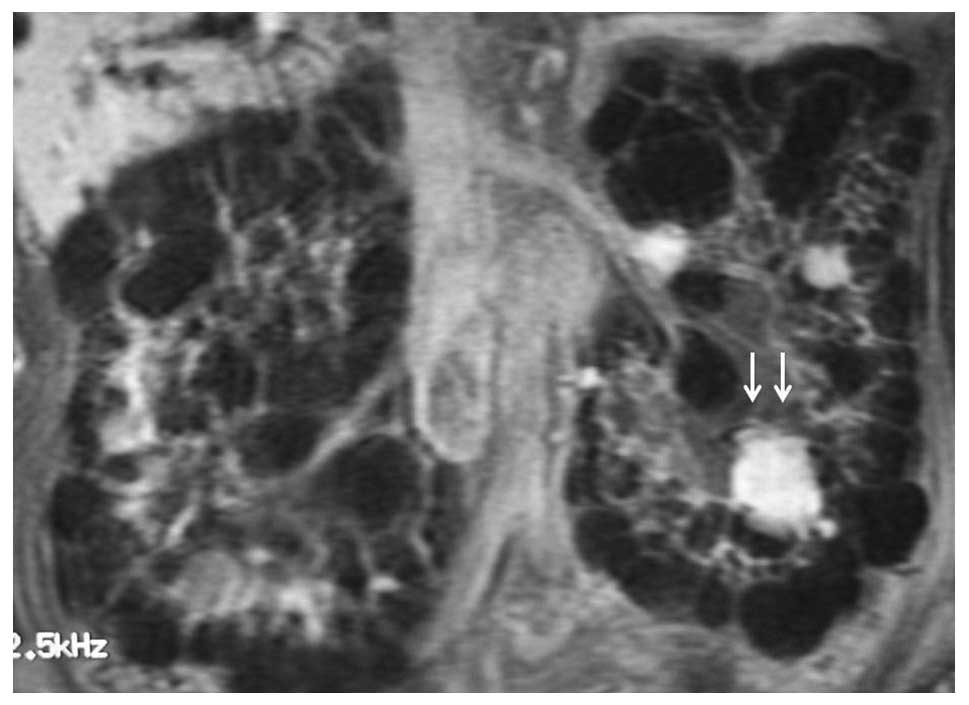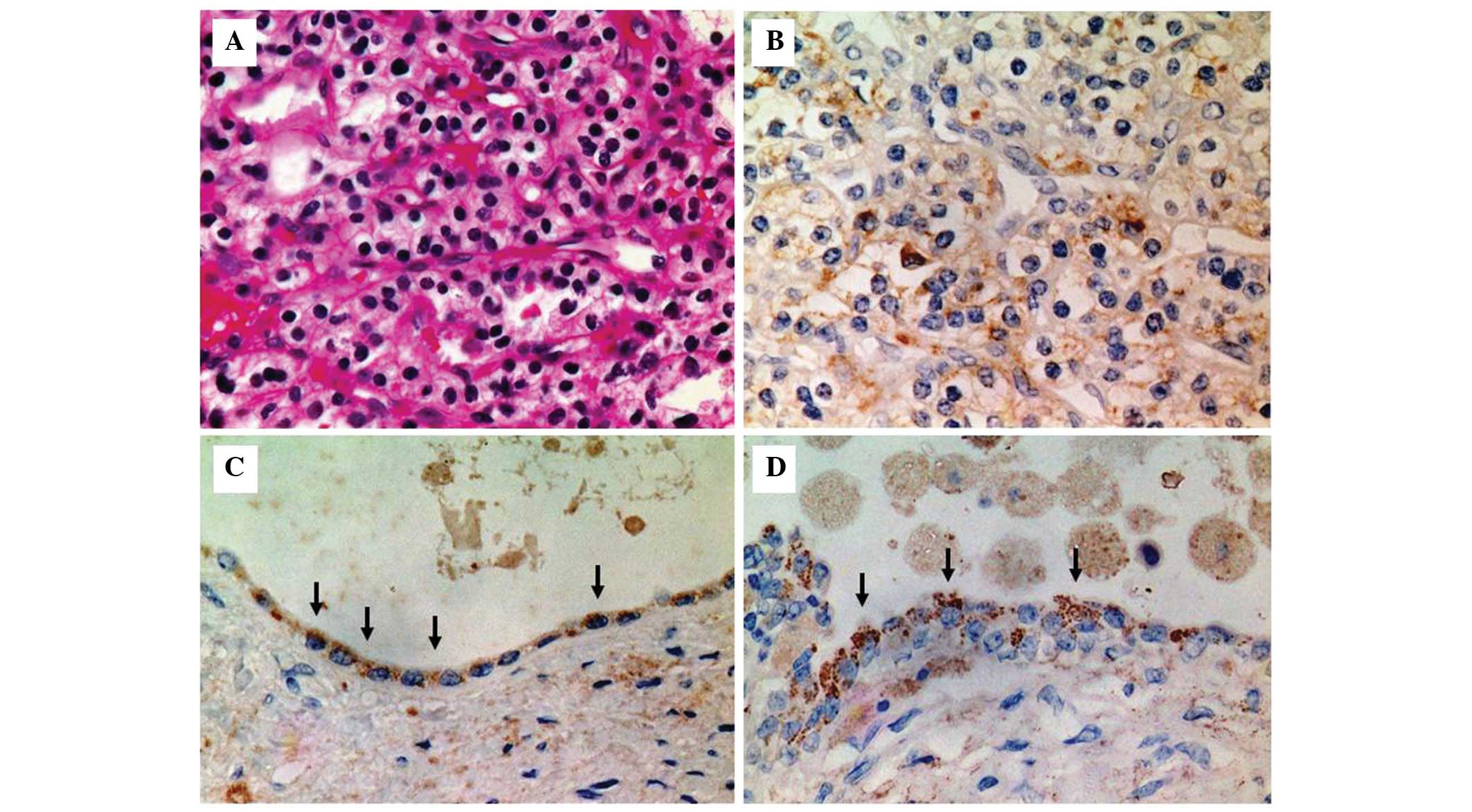|
1
|
Da Silva JL, Lacombe C, Bruneval P, et al:
Tumor cells are the site of erythropoietin synthesis in human renal
cancers associated with polycythemia. Blood. 75:577–582. 1990.
|
|
2
|
Ljungberg B, Rasmuson T and Grankvist K:
Erythropoietin in renal cell carcinoma: evaluation of its
usefulness as a tumor marker. Eur Urol. 21:160–163. 1992.
|
|
3
|
Ito K, Yoshii H, Asano T, et al: Impact of
increased erythropoietin receptor expression and elevated serum
erythropoietin levels on clinicopathological features and prognosis
in renal cell carcinoma. Exp Ther Med. 3:937–944. 2012.
|
|
4
|
Westenfelder C and Baranowski RL:
Erythropoietin stimulates proliferation of human renal carcinoma
cells. Kidney Int. 58:647–657. 2000.
|
|
5
|
Yasuda Y, Fujita Y, Matsuo T, et al:
Erythropoietin regulates tumor growth of human malignancies.
Carcinogenesis. 24:1021–1029. 2003.
|
|
6
|
Hanada T, Mimata H, Ohno H, Nasu N,
Nakagawa M and Nomura Y: Erythropoietin-producing renal cell
carcinoma arising from acquired cystic disease of the kidney. Int J
Urol. 5:493–495. 1998.
|
|
7
|
Ohi K, Yamamoto H, Shigematsu T, et al:
Elevated serum erythropoietin as a marker of renal cell carcinoma
in a hemodialysis patient. Nihon Toseki Igakkai Zasshi. 30:141–145.
1997.(In Japanese).
|
|
8
|
Ooki R, Amamiya M, Umino T, et al:
Elevated serum erythropoietin and IAP as a marker of renal cell
carcinoma in an autosomal dominant polycystic kidney disease. Jin
Touseki. 45:709–711. 1998.(In Japanese).
|
|
9
|
Sakamoto S, Igarashi T, Osumi N, et al:
Erythropoietin-producing renal cell carcinoma in chronic
hemodialysis patients: a report of two cases. Int J Urol. 10:49–51.
2003.
|
|
10
|
Jacobs C, Reach I and Degoulet P: Cancer
in patients on hemodialysis. N Engl J Med. 300:1279–1280. 1979.
|
|
11
|
Hama Y, Kaji T, Ito K, et al:
Erythropoietin-producing renal cell carcinoma arising from
autosomal dominant polycystic kidney disease. Br J Radiol.
78:269–271. 2005.
|
|
12
|
Leak BJ, Javidan J and Dagher R: A rare
case of renal hemangioma presenting as polycythemia. Urology.
57:9752001.
|
|
13
|
Krieg M, Haas R, Brauch H, Acker T, Flamme
I and Plate KH: Up-regulation of hypoxia-inducible factors
HIF-1alpha and HIF-2alpha under normoxic conditions in renal
carcinoma cells by von Hippel-Lindau tumor suppressor gene loss of
function. Oncogene. 19:5435–5443. 2000.
|
|
14
|
Bunn HF and Poyton RO: Oxygen sensing and
molecular adaptation to hypoxia. Physiol Rev. 76:839–885. 1996.
|
|
15
|
Semenza GL: Regulation of mammalian O2
homeostasis by hypoxia-inducible factor 1. Annu Rev Cell Dev Biol.
15:551–578. 1999.
|
|
16
|
Wenger RH and Gassmann M: Oxygen(es) and
the hypoxia-inducible factor-1. Biol Chem. 378:609–616. 1997.
|
|
17
|
Shohat J, Erman A, Boner G and Rosenfeld
J: Mechanisms of the early and late response of the kidneys to
contralateral nephrectomy. Ren Physiol Biochem. 14:103–111.
1991.
|
|
18
|
Lacombe C, Da Silva JL, Bruneval P, et al:
Peritubular cells are the site of erythropoietin synthesis in the
murine hypoxic kidney. J Clin Invest. 81:620–623. 1988.
|
|
19
|
Férnandez A, Hortal L, Rodríguez JC, et
al: Anemia in dialysis: its relation to acquired cystic kidney
disease and serum levels of erythropoietin. Am J Nephrol. 11:12–15.
1991.
|
|
20
|
Shalhoub RJ, Rajan U, Kim VV, Goldwasser
E, Kark JA and Antoniou LD: Erythrocytosis in patients on long-term
hemodialysis. Ann Intern Med. 97:686–690. 1982.
|
|
21
|
Hughson MD, Buchwald D and Fox M: Renal
neoplasia and acquired cystic kidney disease in patients receiving
long-term dialysis. Arch Pathol Lab Med. 110:592–601. 1986.
|
|
22
|
Levine E, Slusher SL, Grantham JJ and
Wetzel LH: Natural history of acquired renal cystic disease in
dialysis patients: a prospective longitudinal CT study. AJR Am J
Roentgenol. 156:501–506. 1991.
|
















